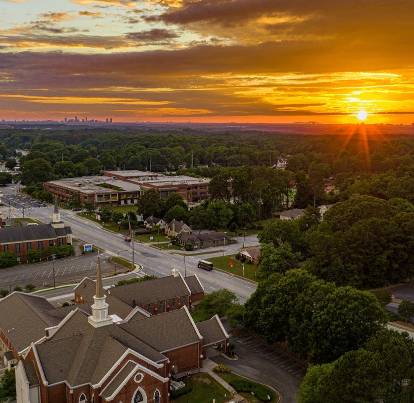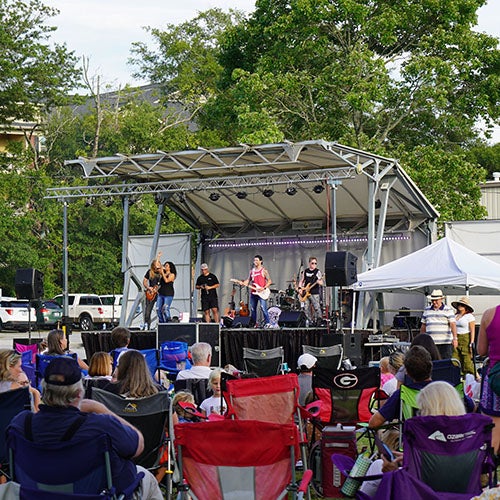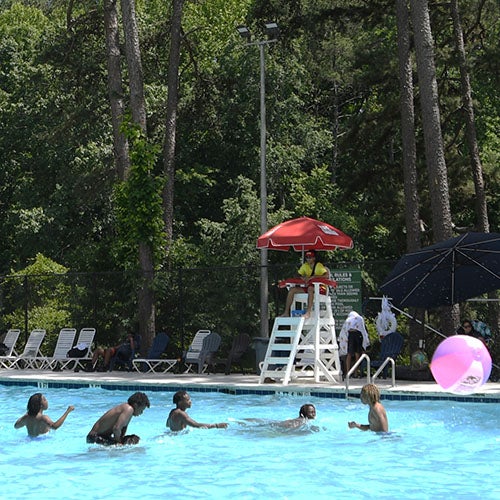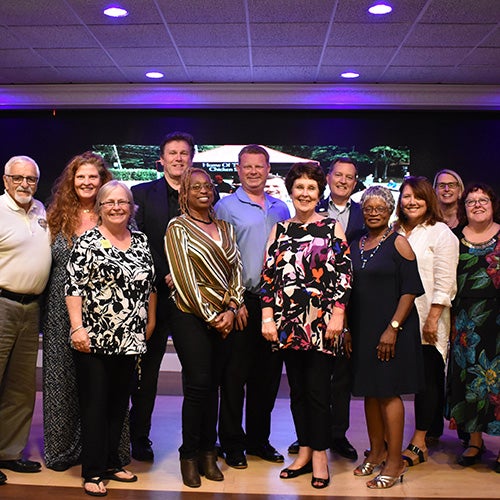InTucker Magazine
September 2023
From the Mayor

For those not already familiar, there was once a spectacular and innovative automobile, known as the Tucker Torpedo, or the Tucker 48, a uniquely pontoon-shaped auto, briefly manufactured in 1948.
The Tucker 48 had an engine in the rear, a curve-tracking third headlamp, real air conditioning, a number of innovative driver safety features, and even had a new kind of transmission the inventor called the “Tuckermatic” (a word we should find some use for!).
The Tucker was unique and brilliant enough that a movie was made about it 40 years after its introduction, in 1988. And yet, only 51 Tucker 48s ever came off the assembly line.
There were varying reasons for that Tucker’s demise, including jealousy, aggressive competition, opposition from others in the auto industry and even opposition from the government.
Moreover, that Mr. Preston Tucker (the inventor) raced toward the future of the Tucker Motor Company without the foundations necessary for long-term, sustainable success.
You might say Mr. Tucker tried to do everything at once, and ended up with nothing. By 1949, he was bankrupt and out of business.
However in fairness to his genius, if you wanted to buy that Tucker automobile today, it would likely cost you in excess of $3,000,000.
There’s no other connection or parallel between Tucker the car and Tucker the City, but maybe some of you have already guessed where I’m going with this.
At seven and a half years old, the City of Tucker has been built on innovation and energy, but it’s also been built with care and patience, for a purpose and for the long haul.
We’ve created a strong foundation that’s built to last for 100 years and then some. But we would have had no place to build and nothing to build with but for the work and sacrifice of volunteers and people who simply loved on the place where they lived over the course of more than 100 years before we became a city.
Now you’ve been hearing me use the phrase Live, Work, Play and Pray for a long time, and in different ways. It’s my way of expressing the elements necessary for a high quality of life, which is always our over-arching goal as a city.
I feel very privileged to lead our city in coordinating multiple efforts to establish prosperity and more desirable outcomes for all the citizens of Tucker, and one of the jobs of a leader is to define the vision.
And then to share that vision, inspiring others to buy in and build support for it. Tonight, I want to talk about the state of our city, using those four pillars of a high quality of life to give perspective on the work we have done, the work we are doing, and the work still to come.
Living in Tucker

So first, we know Tucker is a great place to live. But what makes a place a place?
Well, there has to be some There- There. Many of you know the story – the first there here, as far as the history of Tucker, was Greenville Henderson’s Mill and orchards, granted to him in the early 1800’s as reward for his outstanding military service to Georgia.
This was long before there was a Decatur, or even an Atlanta. He made the Tucker area home for himself and his large extended family. There were farms and farmers in the area, and as more people saw its advantages, more people began to make it their home too. It became a place people wanted to live, because there was work, rail transportation, natural resources, land to own and to farm, and lots and lots of opportunity.
In 1892, this place got a railroad depot and a post office, both called Tucker for the first time, expanding access and opportunity. From there, we grew through the remainder of the Industrial Revolution, the invention and advent of the automobile, two world wars, the Great Depression, and all the other upheavals of American history, more and more people were attracted to live in Tucker.
The biggest housing boom came after World War II, as DeKalb County came into its own, largely due to the visionary leadership of DeKalb’s sole County Commissioner, Scott Candler, and a cadre of other leaders who wanted to keep improving their hometown, even though it wasn’t yet a city.
Many of you live in the homes they built for themselves or for others. The great neighborhoods we know from Edinburgh Estates to Winding Woods, to Wellington, and Smoke Rise and so many others were built to take advantage of the many opportunities to also work, play and pray here.
Our efforts to make and nurture Tucker into a great place to live follow this same formula. We work hard on the other three elements (work, play and pray), in order to continually strengthen the desirability of living here.
Our population has grown by at least 5000 new residents since we incorporated, all of whom chose to make the City of Tucker their home.
To accommodate our growing future, new neighborhoods are being built at Idlewood Station, The Enclave on Lavista, and at Trinity Park. And we’re adding a variety of housing for all incomes and needs.
All in all, we have nearly 1000 housing units comprising apartments, townhomes and single-family detached housing coming online in the very near term.
In the next few weeks, we will release an analysis of all the housing types in and around the city, which will help us determine what we most need to bolster in order to attract new residents who will continue to support our employers, our restaurants and retailers, our greenspaces, and our faith community. We will use that data to design our strategy in planning, zoning, encouraging and nurturing the kinds of housing investments that will have the biggest impact on improving our quality of life.
Working in Tucker
Nobody loves to commute, can we agree on that? So it follows that if we want people to be able to live and work here in Tucker, we must constantly improve and add to live, pray and play aspects that are attractive to employers.
The history of industry and employment in Tucker is a proud one.
As the area evolved from primarily agricultural into one centered around commerce, the railroads played a huge role. Those rail lines carried in the goods people needed and carried out the goods that our industries and farmers produced, all the way back to Greenville Henderson’s fruit and the beverages he made from local crops.
The town that was laid out by the Georgia, Carolina and Northern railroad still forms the core of our downtown and is a bright part of our future one hundred and thirty years later.
Today one of our biggest and most innovative business citizens is also in the beverage business. You might have heard that Pepsico is underway with a $300 million expansion of their plant here, adding hundreds of jobs to what will be one of their most advanced bottling plants anywhere.
We have a building supplies company, Cofer Brothers, whose 100th birthday we celebrated a few years ago, that was literally built on the railroad and has been there ever since. Chip Cofer pointed out to me that the bank on 1st Avenue that was once the Bank of Tucker is now Bank of America, and we have a new community bank called Tandem, whose name itself is a reference to working together.
And speaking of small business, did you know there are over 1200 businesses in Tucker with fewer than 10 employees, and at least another 100 with between 10 and 15?
We have one of the most diverse business communities of any city you can find, and it is the backbone of our economy.
During the 1960’s, some forward thinking leadership and investors began to build the Stone Mountain Industrial Park, bringing dozens and dozens of manufacturers and distributors to the area, and along with North and South Royal Atlanta, which came later, the properties comprising the Tucker Summit Community Improvement District have become one of the most important industrial areas in the county.
As a side-bar, going back to Living in Tucker, one of our largest residential communities, Smoke Rise, was envisioned and largely built by developer Bill Probst, specifically to provide housing for the people who would come to work in those same facilities and industries.
In fact it’s a point of pride for me that I live in a house built by Bill Probst 45 years ago, and that we recently named one of the Smoke Rise parks in his memory.
On the west side of Tucker, Northlake Mall was opened to serve the shopping needs of the region, and businesses grew up all around it. We celebrated the mall’s 50th birthday just last year. And speaking of long-lived businesses, a there’s a cool coin and stamp collector store at Northlake Mall who just passed that same anniversary milestone, having been at the mall since the day it opened.
As the age of the shopping mall has passed, we’re fortunate to have had some very smart and bold investors envision a new future for it. Underway now is a conversion to a multi-use development that already has close to 1600 employees of Emory Healthcare going to work there every day, and will soon include amenities like restaurants, personal services, entertainment, and quality retail, along with another generation of new employers.
We have another important partner, the Tucker Northlake Community Improvement District that works from Northlake all the way through our downtown. As a result of what has happened in that area, the Northlake Office sub-market has among the highest rates of occupancy in the region, with an even brighter future ahead of it.
And to carry this success into the future, this year we completed Tucker’s first-ever Economic Development Strategic Plan. This Strategic Plan was a year-long, deep dive into what’s here now in the way of industry and business and what’s in the future. It addresses how we will leverage our strengths, shore up our weaknesses, and act on both to be ever more attractive to the kinds of employers we want.
For the first time, we have a Plan that provides a road map we can follow instead of constantly veering to the next shiny new thing. This time-investment should guide us toward making smart and thoughtful financial investments, keeping our eyes on the road and avoiding distractions.
Playing in Tucker

Playing in Tucker means different things to different people. For the operations of the City, it certainly centers on our parks system, and I couldn’t be prouder of our accomplishments there.
When we became a city, we acquired about 260 acres in 13 parks that were woefully neglected. It was not that these weren’t great spaces, and not that the Friends of the Parks weren’t doing everything they could, but these parks needed resources, significant reinvestment and professional attention, along with more quality programming to keep them active and attractive.
As with the city itself, we started from scratch. We replaced the playground equipment in every park and added safer surfaces for our children to play on.
We replaced every fence in every park to make them safer as well as more functional. We got the grass in shape, trimmed the trees, added security and lighting, and did everything we could to make them more inviting.
At the Tucker Recreation Center, we replaced the roof, the heating and cooling system, and renovated large parts of the interior.
We refined and added programming, including pickleball, volleyball and basketball courts, fitness facilities and meeting spaces and solar powered equipment for public use during emergencies, as well as providing a performance space for the volunteer-run Main Street Theater company, in the old Cafetorium.
Elsewhere, we’ve completed renovations of Cofer pool and Peters Park, and we’re underway at Rosenfeld Park and Lord Family Park. We’ve added lighting for tennis and soccer in existing parks, and in the next 6-12 months, you’ll see all new fields, including artificial turf, state of the art lighting, and new concessions, restrooms, locker rooms, parking, and pedestrian access at Fitzgerald. And as promised to our partners who donated the property to the city, we are returning the physical space to its former glory, and allowing the leaders there to continue to teach lessons about winning and losing graciously, and all the other life skills that come from competitive team sports.
Since we started our Parks and Rec Department, we have also ADDED over 30 acres in 5 new parks, including Rosenfeld Park, the Church Street Greenspace (perhaps my personal favorite space in the city), the Fitzgerald Sports Complex I just talked about, and our newest, signature park for downtown. We’re in design phase for that one, which will include an amphitheater, shaded seating to enjoy lunch or a play date, and a range of other features for events and for spending your recreational time. We can enjoy the open space for now, but look for construction to begin after the first of the year and to take roughly one year to complete.
But that’s not all we offer in the way of Play. We’ve of course had our extremely successful Main Street events like Tucker Day, Taste of Tucker, the Cruise ins, and many others, all run by volunteers since long before we were a city.
And the city itself has added some that are already a vital part of our community life. Our TKR Summer of Fun includes the annual Celebration of Independence and Fireworks Spectacular, our popular First Friday Concert Series, our Third Thursday Movie Nights and our National Night Out, coming up in October. And let’s not leave out Adult Field Day, a highly competitive day that includes skill events like water balloon tosses and inflatable sumo wrestling suits.
All of this came together following the vision laid out in our first Parks Master Plan 5 years ago. This year, we are conducting our first major update of that plan so that our parks will continue to grow into a world-class system, so please look for your opportunity to participate in developing that plan.
I could go on, but Parks and Rec may require its own “State of the Tucker Parks” event at some point.
Praying in Tucker
The fourth element of our successful future that HAS to be integrated with the others, Pray, is a shorthand way of referencing our faith community. For good reason, this is the element the government has the least direct role in, but which is the most directly vital to our community’s spiritual health, sense of purpose and well-being. It undergirds and makes sense of why we work on all the other elements.
From the time this area was settled, through all the other history we’ve discussed, churches and faith organizations have been part of the fabric of Tucker.
A few years ago, I gave this State of the City report, and I challenged that audience to just imagine if somehow, suddenly, the churches and other faith-based organizations in Tucker simply disappeared.
Who would feed the hungry, visit the sick? Who would come alongside you when you lost a job or a loved one? Who would provide resources to the destitute, and lovingly help them get back on their feet? Where else are we reminded of how meaningful life can be, but also that there is so much more to our existence than what we can see, feel and touch every day?
Government certainly can’t do those things – I’ve said many times that it’s people who have the capacity for love, and people who work and serve in government can and do express their love through their work. But government as an institution cannot love its neighbor. It’s just not built for that.
That’s why we are blessed to have multiple Baptist, Methodist, Presbyterian, Pentecostal, and Lutheran, Catholic, Mormon and dozens of other denominational and non-denominational churches leading in love.
They collectively hold services in a variety of languages, including Spanish, Chinese, Korean, and Vietnamese, even Hebrew and Aramaic. Muslim and Buddhist Temples and Jewish Synagogues help to weave our Tucker tapestry of faith.
Our role as a city government and as citizens, is to continually acknowledge and recognize the irreplaceable role which our faith community plays and the many needs they fill. We are served and made better by them, individually and as a community. We want to nurture them, honor them, and encourage them on their mission and as they do their work.
So we’ve talked about our history and recent and current work in the context of these four pillars of Tucker community life, and I’d like to close with some thoughts about the future and how these principles will continue to guide our progress over the next 2 and a half years.
Let’s Start Here

If you could afford that $3,000,000+ price tag, you could probably find a Tucker 48 for your very own. It would be super-cool. You could show it off to your friends, maybe drive it around town enjoying its once-upon-a-time advanced features, maybe even take it down to the Tucker Cruise-In and share it with the motorheads. But its functions would be pretty limited to its time and the very specific things it was built for.
You could never ford a creek in it or climb a 30-degree incline like you could with a Jeep, for example, and you’d do more harm than good if you tried.
You couldn’t tow your boat to the lake, or your trailer to a jobsite – The Tucker Torpedo might have been an engineering wonder, but it just wasn’t built for those tasks.
It probably couldn’t even keep up with traffic on today’s 285.
Likewise, our City of Tucker was built and is being built with purpose, planning and vision. If we attempt to use it contrary to its purpose, we may do more harm than good.
So as we plan and work toward the future, the first and most important thing is to understand what our purpose is, what our capabilities are, and then deploy those capabilities to maximum advantage for our purposes.
We’ll be at our best when we are doing the things that only we can do, or the things that we can clearly do better for ourselves than some other subdivision of government. We’ll succeed when we focus relentlessly on the things we are built for, like taking care of common needs for a safe and attractive city, effective transportation, and appealing recreational facilities, which lead to investment by businesses and families. And we’ll be at our best in the future only if we build something that does all the things we need it to do today AND is upgradeable to address the future, and not stuck in time like an antique car.
So we’ll continue building and improving our roads. We expect to spend in excess of $5,000,000 per year on them over the next six years; we will accelerate construction of 32 miles of multi-use trails (which will take tens of millions of dollars, some of it hopefully Other People’s Money); we’ll make massive stormwater and drainage system improvements citywide; and we’ll continue to add to the appeal of our parks to make them one of the big reasons people want to live, work, play and pray here.
To accomplish all of this, we will also need new leadership for Team Tucker. In fact, If I was doing a SWOT analysis (and I have), the greatest potential threat on my list would be that we might fail to encourage enough of the thoughtful, level-headed leaders in our community to help keep us on course as elected officials. People who run for the right reasons and with a right understanding of our role and our purpose.
It’s not the purpose of tonight’s event, but it makes me think of the story of Catch-22. Do you remember? It was a novel about the cold war, and a squadron of pilots continually being sent on a series of very dangerous missions.
The Catch in Catch-22 was, the pilots who were eager to go, who thought it was just awesome and exciting, were deemed not fit for duty. As long as you didn’t want to go, because you recognized the difficulty and risk involved, you were deemed sane and qualified and had to continue on the missions. So I’m sorry to break it to you, but if you’re a volunteer who’s doing the hard, sometimes thankless work for the right reasons, serving on city council may be your next mission. If it seems daunting and hard and scary and thankless, please take my word for it – that understanding is the first qualification, and I’d love to talk to you about it.
I’m only half-kidding about that, but whether you ever run for office or not, we know that our Volunteer Leaders will always be our greatest strength. Your continuing servant leadership and giving back, will remain the special additive of the fuel that drives our Tucker forward.
We are blessed to live in the great state of Georgia, and in metro Atlanta, a large community that is diverse, resilient and full of resources. It is among the nation’s most successful and vibrant, by most every definition.
Within that larger space Tucker is special, and it’s special because of the people who live, work, play and pray here, and who make sacrifices to enhance our quality of life. As your Mayor, and on behalf of our entire family, we are continually honored to serve you.


